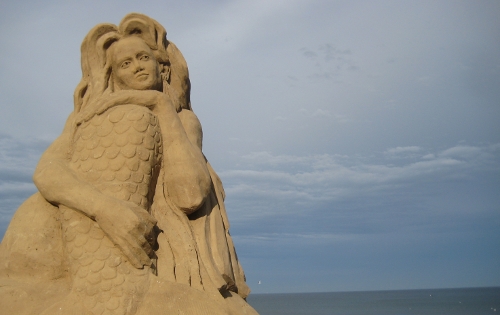
Wir sind heute tatsächlich auf Rügen geblieben – und haben uns der Bäderarchitektur gewidmet. Die findet man hauptsächlich an der Ostsee, seit 1810 auch auf Rügen. Viel wurde in der Gründerzeit gebaut. Wir hatten uns Göhren, Sellin und Binz vorgenommen. Schon in Göhren habe ich viele Fotos gemacht, aber letztlich waren die anderen Städte deutlich beeindruckender. So bleibt mir aus Göhren nur der Mega-Anker in Erinnerung, der vor dem Heimatmuseum liegt.
We did stay on Rügen today – and dedicated the day to resort architecture. Or, as I have also seen „translated“, Bäderarchitecture. What I have now also seen translated, by the way, is Rügen: Rugia Island. Anyhow, this architecture is mainly found in German spa resorts on the Baltic Sea coast. The first building on Rügen is from 1810 but construction overall peaked during the Gründerzeit epoch. We had Göhren, Sellin and Binz on our schedule. I took many pictures in Göhren already but really the other two cities turned out to be MUCH more impressive. So what I will always remember Göhren for is the humongous anchor that lies in front of the museum of local history.
Mal sehen, wann ich fertig werde mit diesem Post. Unmengen an Fotos, die allermeisten schön, letztlich jedoch mit ähnlichen Motiven. Häuser halt. Ich konnte es auf 20 runterdampfen. Dann 17. Es wird also ein kleines Album werden. Fahren wir weiter nach Sellin.
We’ll see when I will finally finish this post. There’s an incredible number of pictures, most of them beautiful but with similar motifs. Houses, right. I managed to get the count down to 20. Then 17. This will be a small album, can you tell? Let’s have a look at Sellin now.
Was mir an Sellin besonders gefallen hat waren die Schautafeln, die vor historisch besonders interessanten Häusern angebracht waren. So war es einfach und übersichtlich, sich ein Bild von der bewegten Geschichte, die eigentlich alle diese Häuser hinter sich haben, zu machen.
What I really liked about Sellin was the fact that there were information panels in front of all the houses that were of particular historic interest. Hence, it was really easy to get an overview and learn more about the eventful history that practically all these houses have.
Im zweiten Weltkrieg wurden sie bspw. umgewandelt in Flüchtlingslager oder für die Kinderlandverschickung verwendet. Zu Zeiten der DDR wurden die Besitzer enteignet und die Gebäude bspw. vom Ministerium für Gesundheit der DDR benutzt. Nach der Wiedervereinigung scheinen fast alle an ihre enteigneten Besitzer zurückgegangen zu sein. Aber nicht alle haben es im Originalzustand geschafft.
During World War II they were sometimes used as refugee camps or for KLV, the evacuation of children during the war. At the time of the former GDR the owners were expropriated and the houses then used by, e.g. the Ministry of Health of the GDR. After reunification most seem to have been returned to their rightful owners. But not all were returned in their original stae or rather: design.
Die Häuser sind gigantisch: Haus Eintracht (1909) ist 13,63m lang, 11,26m tief. Im Erdgeschoss gab es ursprünglich neben einer Küche 6 Zimmer und einen „Abort“. Im ersten Stock dann 8 Zimmer und einen „Abort“, in der Mansarde dann nochmal 6…
The houses are huge: Haus Eintracht (House Harmony), from 1909, is 13.63 by 11.26 meters. There were originally a kitchen and 6 rooms on the ground floor and a lavatory, another 8 rooms and a lavatory on the first floor and another 6 rooms in the attic…
Es wurde in der Lokalpresse 1901 festgehalten, dass der „Villenbau des Fräulein Johanna Richert“ begonnen wurde – das Haus Ingeborg. Die wunderbare Holzveranda mit reicher Ornamentik ist noch im Original erhalten. Und irgendwie war das Haus immer in der Hand „von selbstbewussten und selbstständigen Frauen“:
The local paper stated in 1901 that „the building of the villa by Miss Johanna Richert“ was started – Haus Ingeborg. The beautiful wooden verandah with its detailed ornamants is still the original. And somehow this house was always in the hands of „self-confident and autonomous women“:
Aber in Sellin gibt es auch eine schöne Seebrücke… zu der man aber erst einige Stufen absteigen muss. Steilküste – ich hätte es wissen müssen, aber ich war dennoch überrascht.
But Sellin also has a gorgeous pier… that you have to climb down to. Steep coasts – I should have known yet it still came as a surprise.
Nächster Stop: Binz – wo auch schon das erste Foto dieses Eintrags herkommt. Da war deutlich mehr los als in Sellin und es war schicker. Das Kurhaus ist zu groß, um es ganz auf’s Bild zu bekommen.
Next stop: Binz – where I took the very first picture of this post as well. It was a lot livelier than Sellin and it was somehow fancier. The Kurhaus (center of a spa resort) is too large to photograph in its entirety.
Die Bäderarchitektur ist auch hier zu finden und sehr ähnlich, aber doch anders – häufiger auch in weniger verspielten Holzfassaden, dafür Stein und Stuck, hier und da auch in Backstein.
You find the Bäderarchitecture here as well but it’s same, same but different so to speak. It also had the playful, richly ornamented wooden verandahs etc. but also a lot of stone and stucco, sometimes even brick.
Sagt sie und stellt fest, dass die ausgewählten Fotos dann doch fast alle verspielte Holzelemente aufweisen… Also kommt zu den 17 Fotos noch eins dazu: die Villa Glückspilz!
Says she and realizes that almost all the pictures chosen have the wooden ornaments after all… So I will add another picture to the 17 I thought I could make do with: Villa Glückspilz! (Villa Lucky Devil which when translated literally from German would be Villa Lucky Mushroom…).
Es darf außerdem festgehalten werden, dass ich am 23.10.2013 bei gefühlten 5°C Wassertemperatur (es waren wohl tatsächlich 11°C) nicht davon abgehalten werden konnte, meine Füße von den Ostseewellen umspülen zu lassen.
Please note that on October 23, 2013 I could not be held back from having my feet bathed in Baltic Sea waters at what felt like 5°C/41F (when in fact it was 11°C/52F).
Und kurz vor Abfahrt brachte ich noch in Erfahrung, was in Binz das Äquivalent zu nervenden Quads in der Eifel ist… siehe links.And shortly before we left I found out that Binz has an equivalent to the hugely annoying quad bikes cruising through the Eifel… see left.
Bis bald!
Take care!
Barbara


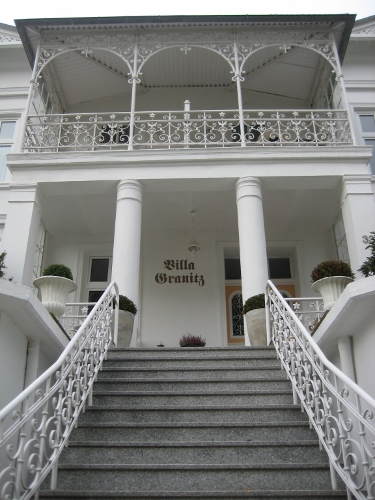
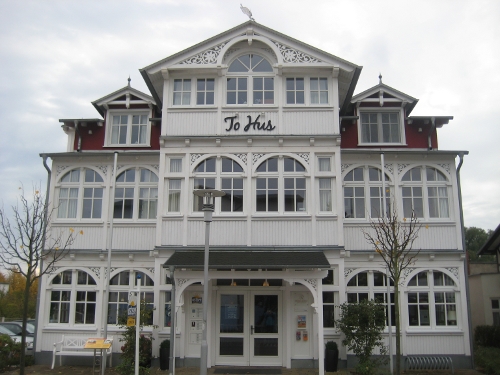
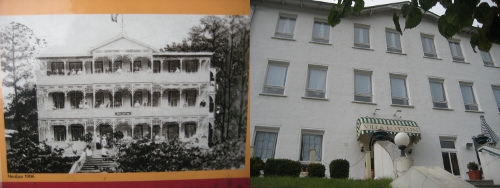

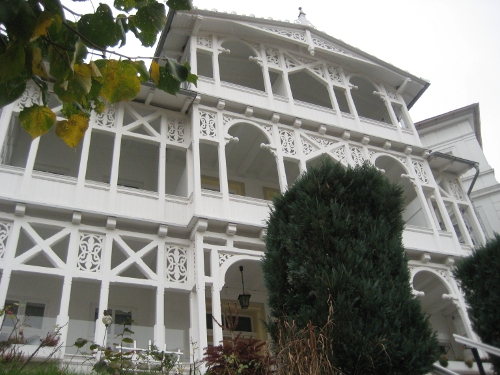

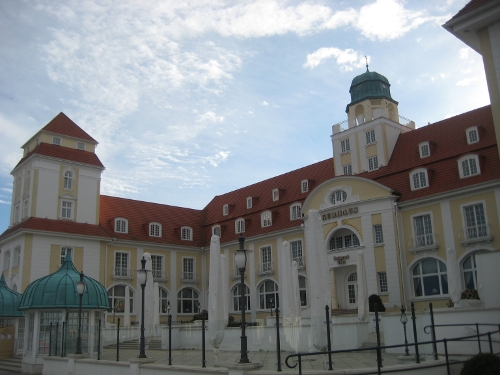

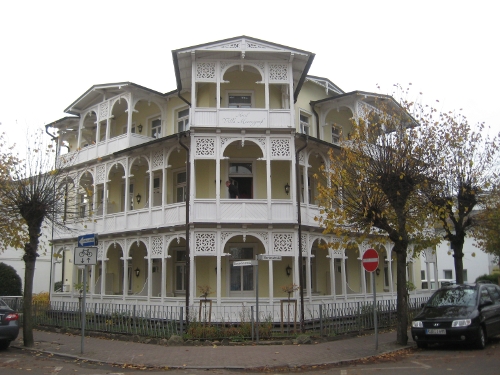





Hahahaha, a segway!
Lovely pictures!
Beautiful detail on the verandas!
LikeLike
Eine Traumreise.
LikeLike
Binz ist toll, oder?
So coole Häuser. Rügen ist an sich ne schöne Sache.
LikeLike